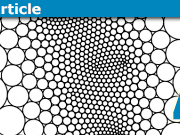Learn the Top Misconceptions about Virtual Particles
This Insight Article is a sequel to the Insight Article ”The Physics of Virtual Particles”, which contains an exposition of definitions that are physically justified, and in particular, makes precise what a virtual particle is and what being real means. As discussed in detail in the companion article, virtual particles are defined as (intuitive imagery for) internal lines in a Feynman diagram. Their name derives by analogy to the external lines, which may be linked to observable stable or unstable particles. The 4-momentum vector of a virtual particle has the physical meaning of an integration variable in the integral corresponding to the diagram, and takes all possible values, making it off-shell.
States involving virtual particles cannot be created since quantum field theory has creation operators only for observable particles whose 4-momentum satisfies the mass-shell constraint. For lack of a state, virtual particles have none of the usual physical characteristics of real particles: They cannot be said to exist in space and time, have no position, no meaningful probabilities to be created or destroyed anywhere, no lifetime, cannot cause anything, interact with anything or affect anything – since all these things are (within the unavoidable uncertainty) determined by the state. Therefore there are also no dynamics, speed of motion, or world lines. (In physics, dynamics is always tied to states and an equation of motion. Neither exists for virtual particles.)
Though QFT computations generally use the momentum representation, there is also a Fourier-transformed complementary picture of Feynman diagrams using space-time positions in place of 4-momenta. In this version (relevant for perturbation theory in curved space-time), the integration is overall of space-time, so in this picture, virtual particles have space-time positions but no momentum, and again no states, no probabilities, no cause and effect, no dynamics, and no world lines.
In the nonperturbative lattice approach to quantum field theory, virtual particles are completely absent, another proof of their unreal, ”virtual” nature.
The only way the usual dynamical language for virtual particles is justified by the theory is as purely figurative analogy in ”virtual reality”, useful for an informal talk about complicated formulas and for superficial summaries in lectures capturing the imagination of the audience.
This has to be kept in mind when reading professional scientific publications statements involving virtual particles. Otherwise, many statements become completely misleading, inviting a magical view of microphysics and weird speculation, without the slightest support in theory or experiment. How the latter view could arise is described in another Insight Article, ”The Vacuum Fluctuation Myth”.A further Insight Article, ”Vacuum Fluctuations in Experimental Practice”, shows the example of a recent article in the scientific literature which some authors claim the observation of vacuum fluctuations, is justified only by superficial, invalid reasoning. See also the extended discussion accompanying the present article.
Table of Contents
Contents
In the present Insight article, I’ll go through several Wikipedia pages and comment on their misleading statements about virtual particles and Feynman diagrams. I chose Wikipedia because of its high impact on lay readers. Note that textbooks on particle physics or quantum field theory may also contain such misleading statements – though only in informal statements about virtual particles accompanying real calculations. Such informal statements are never made precise on a physical level since the latter is simply impossible.
But these misleading statements are then copied uncritically and out of context into Wikipedia, where a ”reliable” source such as a textbook, a refereed journal article or even just a popular science book (!) seems sufficient justification to spread nonsense. Indeed, Wikipedia’s quality scale for physics articles considers the following physics publications as being of comparable quality, namely level Mid: [note: comments in brackets are mine]:
High impact physics journals. Books famous enough to be known by their author only to most of the physics community. Famous popular science publications.
Examples: Classical Electrodynamics [by whom?],
Course of Theoretical Physics [by Landau and Lifshitz?],
Physical Review [a flagship journal],
A Brief History of Time [by Stephen Hawking],
The Elegant Universe [by Brian Greene], …
though there is a huge difference in quality and accuracy between the first three examples (for scientists) and the last two (very simplified – and hence very inaccurate – accounts for laymen).
In addition to a detailed discussion of certain Wikipedia pages, this article discusses textbooks and the extent to which they contain problematic formulations about virtual particles – as I get to know them or remember some on my own that I had seen in the past. Please send me an email at Arnold.Neumaier@univie.ac.at if you know of a textbook that is not yet in the list below but contains improper claims about virtual particles. In particular, mention the places where the claims are made – as I won’t have the time to work through everything. Please do the same when you know of Wikipedia pages not listed below containing improper claims about virtual particles not yet discussed here. (Since Wikipedia pages change over time, this article will continue to refer to defective versions even when mistaken claims are removed in later versions. However, if I get informed about corrections I’ll mention them here.)
The current version of this article concentrates on two Wikipedia articles on Feynman diagrams,
and on three well-known books,
Diagrammatica: the path to Feynman diagrams by Martinus Veltman
The quantum theory of fields I by Steven Weinberg
An introduction to quantum field theory by M.E. Peskin and D.V. Schroeder.
These articles and books are discussed in some detail below. (I comment elsewhere on the book ”The Quantum Vacuum” by P.W. Milonni, which freely mixes the mythical language for laymen with real physics, justifying it only by appealing to the imagination for interpreting formulas that ostensibly say nothing mythical at all.)
Critique of some Wikipedia pages on virtual particles
The main entry on Feynman diagrams (revision as of 21:40, 19 February 2016) explains on the top right a tree diagram in a completely misleading way:
”In this Feynman diagram, an electron and a positron annihilate, producing a photon (represented by the blue sine wave) that becomes a quark-antiquark pair, after which the antiquark radiates a gluon (represented by the green helix).”
Physical electron-positron annihilation never produces a single virtual photon as drawn in the diagram and explained in the caption – but always two real photons (or more, with much lower probability).
(The latter is described later on that page as a correct scattering process – except that they forget to say there that the intermediate particles and processes are virtual, not something that happens, and that they also add spurious, misleading space and time axes. In the center of the mass frame, the in-particles would come in from opposite directions, and the out-particles would leave in another opposite direction, using a semiclassical picture of the scattering process appropriate for tree diagrams.)
The correct description of the diagram is that it gives one of the two possible terms in the tree approximation of a scattering process in which an electron and positron collide and decay into a quark-antiquark pair and a gluon. One cannot talk meaningfully about the claimed intermediate events in the temporal ordering suggested by the time coordinate underneath the diagram itself.
Similarly, a single photon cannot decay into a quark-antiquark pair.
Later in that entry, the section ”Particle-path interpretation” contains in the first and fourth paragraphs pure nonsense – not at all justified by all the preceding information given.
”A Feynman diagram is a representation of quantum field theory processes in terms of particle paths. The particle trajectories are represented by the lines of the diagram, which can be squiggly or straight, with an arrow or without, depending on the type of particle. A point where lines connect to other lines is an interaction vertex, and this is where the particles meet and interact: by emitting or absorbing new particles, deflecting one another, or changing type.”
Feynman diagrams don’t describe particle paths – but integration processes.
An interaction vertex is not where the particles meet and interact – but a point describing an interaction term in the space-time form of the Lagrangian of the defining theory, expressing momentum conservation in the corresponding integration in the Fourier domain.
Real collisions never happen at a well-defined point – but always in a region of significant extension.
Feynman diagrams are often confused with spacetime diagrams and bubble chamber images because they all describe particle scattering. Feynman diagrams are graphs that represent the trajectories of particles in intermediate stages of a scattering process. Unlike a bubble chamber picture, only the sum of all the Feynman diagrams represent any given particle interaction; particles do not choose a particular diagram each time they interact. The law of summation is in accord with the principle of superposition—every diagram contributes to the total amplitude for the process.
Feynman diagrams don’t describe particle scattering – but partial contributions to S-matrix elements.
Feynman diagrams don’t represent the trajectories of particles in the intermediate stages of a scattering process – but integrals arise in their perturbative computation.
The sum of all the Feynman diagrams represents not a given particle interaction but (if the in-and out-momenta are fixed) a particular S-matrix element.
The superposition of states is not related to the summation of the diagrams – but to taking linear combinations of S-matrix elements with variable in-and out-momenta.
The remainder of the entry is technical and reasonably accurate (I didn’t check all details since they are irrelevant to the present thread), with a few notable exceptions – though these mistakes have nothing to do with virtual particles, they show the amount of care given to the content of the page:
In the section ”Path integral formulation”, the concept of Wick rotation is misapplied; it doesn’t mean ”a little bit rotated into imaginary time”.
In the section ”Scattering”, it is erroneously claimed that Wigner’s definition of a single-particle state through an irreducible representation of the Poincaré group doesn’t apply to quarks. (The claimed reason – confinement – has nothing to do with their claim.) Instead, they promote an erroneous ”modern point of view” that a particle is anything whose interaction can be described in terms of Feynman diagrams, which have an interpretation as a sum over particle trajectories. Given the content of reference [3] of the page (that perturbation theory for classical field theory produces Feynman diagrams), this would turn classical field theories into theories of particles!
Where do these misinterpretations come from? wikipedia prides itself that
”anyone using the encyclopedia can check that the information comes from a reliable source. Even if you’re sure something is true, it must be verifiable before you can add it. When reliable sources disagree, present what the various sources say, give each side its due weight, and maintain a neutral point of view.”
Therefore, many articles contain a box with a comment stating that ”This section needs additional citations for verification. Please help improve this article by adding citations to reliable sources.” No such box appears in the present article.
Thus one should be able to conclude that the cited sources contain all the misinterpretations mentioned. To test this, I checked one of them (Martinus Veltman, Diagrammatica) and was positively disappointed – the book is without blame; see the discussion below. I leave it to my readers to check the other 12 references and find the presumably ”reliable” origin of these misinterpretations (should there be such an origin) – please inform me of the results of your search.
The Wikipedia page on Feynman diagrams also has a less technical version (linked to at the top of the page) of the article on Feynman diagrams on the Simple English Wikipedia (revision as of 08:29, 10 October 2015).
Here the description of the Feynman diagram discussed above reads:
”In this Feynman diagram, an electron and positron destroy each other, producing a virtual photon which becomes a quark-antiquark pair. Then one radiates a gluon”
This description is slightly better as it at least acknowledges that the photon is virtual. However, all other processes in this description and their temporal order are still products of the imagination only.
Moreover, the first three paragraphs of the main text are the worst science fiction – even taking into account that the ”Simple English Wikipedia is for everyone! That includes children and adults who are learning English.”
”A Feynman diagram is a diagram that shows what happens when elementary particles collide.”
”Feynman diagrams are used in quantum mechanics. A Feynman diagram has lines in different shapes—straight, dotted, and squiggly—which meet up at points called vertices. The vertices are where the lines begin and end. The points in Feynman diagrams where the lines meet represent two or more particles that happen to be at the same point in space at the same time. The lines in a Feynman diagram represent the probability amplitude for a particle to go from one place to another.”
”In Feynman diagrams, the particles are allowed to go both forward and backward in time. When a particle is going backward in time, it’s called an antiparticle. The meeting points for the lines can also be interpreted forward or backwards in time, so that if a particle disappears into a meeting point, that means that the particle was either created or destroyed, depending on the direction in time that the particle came in from.”
A Feynman diagram is not a diagram that shows what happens when elementary particles collide
– but a diagram that shows one of the possibilities of how a collision process can be decomposed by elementary particle physicists.
The vertices in Feynman diagrams where the lines meet do not represent two or more particles that happen to be at the same point in space at the same time. (This would be an extremely unlikely event.) – But they represent an elementary interaction in the computational chain leading to the probability amplitude of the complete collision process.
The lines in a Feynman diagram do not represent the probability amplitude for a particle to go from one place to another. – But they represent an ingoing or outgoing particle in the collision if they have only one vertex, and an auxiliary virtual particle is introduced into the analysis through the decomposition mentioned.
In Feynman diagrams, the particles are not allowed to go both forward and backward in time. (There is no time involved at all.) – But the arrows drawn on the Fermion lines represent conservation laws (of charge for electrons and positrons, of baryon numbers for quarks and antiquarks)
Antiparticles are not particles going backward in time – but mirror particles with the opposite quantum numbers.
In the diagram, particles are neither created nor destroyed; the lines don’t have the meaning of particle paths so there is nothing to be created or destroyed.
The remainder is perhaps acceptable if taken with a big grain of salt, as perhaps appropriate for a formula-free treatment of the subject. Except for the meaningless last sentence, ”The probability amplitude for the emission is very simple – it has no real part, and the imaginary part is the charge of the electron.” It is not even clear what this should mean in a very liberal figurative interpretation of everything.
Given the obsession of wikipedia with ”reliable” sources one should think that the book [1] (the only reference given) states all this nonsense, but this isn’t so. In spite of its title (Diagrammatica), which let me fear the worst, this book (discussed in the book list below) didn’t contain a single mention of the word ‘virtual’ or ‘destroyed’, and only once each the words ‘antiparticle’ and ‘backward’ (both in a completely different context).
If the writers of the two Wikipedia articles considered would have taken their source seriously, they wouldn’t have had the occasion to make any of the misinterpretations reported here.
Books on quantum field theory and their usage of virtual particles
The book ”Diagrammatica: the path to Feynman diagrams” is a textbook on quantum field theory covering the standard ground up to QED in an essentially standard manner, written by Martinus Veltman, one of the few physicists who earned a Nobel Prize for their work in quantum field theory, the theory behind Feynman diagrams. The book is highly recommended reading for anyone who wants to know the truth about processes involving particles and has – or is prepared to acquire – the necessary mathematical background.
Veldman’s book explains in an exemplary way what Feynman diagrams are and how they are interpreted and used. From the introduction:
”Perturbation theory means Feynman diagrams. It appears therefore that anyone working in elementary particle physics, experimentalist or theorist, needs to know about these objects. […]
This then is the aim: to make it clear which principles are behind the rules, and to define clearly the calculational details. This requires some kind of derivation. The method used is basically the canonical formalism, but anything that is not strictly necessary has been cut out. No one should have an excuse not understanding this book. Knowing about ordinary non-relativistic quantum mechanics and classical relativity one should be able to understand the reasoning.”
Let me emphasize again, this technically precise (though not mathematically rigorous) book contains not a single mention of the word ‘virtual’.
Happy reading!
The quantum theory of fields I by Steven Weinberg, another physicist who earned a Nobel Prize for their work in quantum field theory, is the first, introductory part of a trilogy on quantum field theory. It is the textbook that does the best job of explaining why quantum field theory necessarily takes the form that can be found everywhere. It is also of high technical precision, but also not fully rigorous. (The development of a fully rigorous 4-dimensional quantum field theory on the basis of the Wightman axioms or the axioms of local quantum physics is still a wide-open research problem, part of which constitutes one of the Clay millennium price problems.)
Weinberg mentions virtual particles in the historical introduction (on p.32 and p.36) and then again very late in the book, long after having introduced Feynman diagrams, and without clearly defining them – thus demonstrating how little they mean in the theory. The first usage in the main text is on p.429, where virtual particles are implicitly introduced in the caption of Figure 10.1: ” Here straight lines represent virtual electrons; wavy lines represent real and virtual photons”. Then p.446 mentions some of the associated imagery: ” This helps us to understand how a particle like a proton, that is surrounded by a cloud of virtual mesons and other strongly interacting particles, can have the same charge as the positron, whose interactions are all much weaker.” Further occurrences are on pages 489,490,519,528, 539-576, all strictly related to diagrams and formulas, without any allusions to reality. in addition, there are three cases where virtual particles are described as being active in some sense – possibly suggesting to the casual reader some implied reality:
p.540, caption: ”radiative corrections due to virtual soft photons” – but this is not a causal statement; its meaning is ”due to Feynman diagrams containing virtual soft photons”.
p.543: ”we have included diagrams in which the virtual photon is absorbed and emitted” – but this is not something happening in reality, only vivid talk about properties of the diagrams.
p.543: ”soft virtual photons produce infrared divergences” – clearly showing that virtual particles are unphysical imagery since they produce unphysical results)
An introduction to quantum field theory by M.E. Peskin and D.V. Schroeder is one of the most popular introductory textbooks on quantum field theory, at a level significantly more elementary than that of Veldman or Weinberg, and correspondingly more sloppy. (Indeed, it seems that in general, the more elementary a book or article, the more use is made of sloppy virtual imagery that tries to give abstract formulas and intuitive – though misleading – meaning. This becomes more and more pronounced as the presentation shifts more and more towards explanations aimed at nonphysicists, and is fully developed in Wikipedia.)
In this book virtual particles occupy a more serious place, the term is used frequently from the beginning and even appears with multiple references in the index. Only a selection of usage examples is given, including the ones where virtual particles appear to play an active role.
P&S defines virtual particles formally on p.5, ”internal lines representing virtual particles, in this case, one virtual photon”.
p.113 talks about the ”creation and annihilation of additional virtual particles”, p.149 about ”the amplitude for creation of a two-particle state from a point-like virtual photon”. p.155 asserts that ”Coulomb scattering […] arises from the nearly on-shell […] virtual photon”, p.184 mentions a ”correction to electron scattering that comes from the presence of an additional virtual photon”, p.209 comments ”It is tempting to guess that in this limit the virtual photon becomes a real photon. Let us investigate in what sense that is true.” (The conclusion presenting the figurative sense implied is never drawn but left to the reader’s imagination.) And many more uses, the more interesting ones in our context being:
- p.245: ”the photon self-energy. It can be viewed as a modification to the photon structure by a virtual electron-positron pair.”
- p.255: ”Virtual ##e^+e^-## pairs are effectively dipoles of length ##\sim 1/m##, which screen the bare charge of the electron.” […] ”virtual ##e^+e^-## pairs make the vacuum a dielectric medium […]
This phenomenon is known as vacuum polarization.” - p.259: ”Strongly interacting particles – pions, kaons, and protons – are produced in ##e^+e^-## annihilation when the virtual photon creates a pair of quarks.”
- p.393: ”The quantum fluctuations at arbitrarily short distances appear in Feynman diagram computations as virtual quanta with arbitrarily high momenta.”
- p.458: ”the process of virtual pair creation makes the vacuum a dielectric medium”
- p.479: ”fermions interact by exchanging virtual particles”
- p.541: ”The vacuum acquires a dielectric property due to virtual electron-positron pair creation, causing the effective electric charge to decrease at large distances.”
- p.548: ”in which free quarks are created by a virtual photon”
- p.550: ”It is not difficult to understand the cancellation of infrared logarithms intuitively. […] In the diagrams with gluon emission, the virtual quark or antiquark is off mass-shell by an amount
[…] Thus this virtual state survives for a time […] before it decays” - p.583: ”In this picture, the electron seen at one resolution can be resolved at a finer scale into a more virtual electron and a number of photons. […] it is useful to imagine the splitting of the electron into a virtual electron plus photons”
It is characteristic of the usage of virtual particles everywhere in the literature that no definitions are given of how a virtual particle can be active in any of the senses quoted. The reason is that it is impossible to make verbal analogies precise enough to constitute real physics. The formulations are therefore only illustrative talk and plausibility arguments for anchoring the formulas and diagrams into the reader’s imagination.
Indeed, every single use by P&S of the term virtual is linked to specific diagrams and/or computations, never to a real process in which the virtual particles take a temporal role. As it must be because of the underlying theory, the real process under discussion is always the complete scattering event between real (on-shell) particles, of which a single Feynman diagram is only shorthand for one of the infinitely many terms in the complete expression for the scattering amplitude. Even when dynamic language is used, it is only figurative talk about the diagram – nowhere the slightest hint is given of how this figurative talk could translate into a process in real-time. The purely virtual nature of virtual particles can also be seen from statements such as ”We can make a virtual photon by picking two-photon momenta ##k_i## and ##k_j## setting ##k_j=-k_i=k##, multiplying by the photon propagator, and integrating over ##k## on p.206 – referring to symbolic activities, not real ones.
Full Professor (Chair for Computational Mathematics) at the University of Vienna, Austria








Interesting; I will have to read this in greater depth when I get home. One of the ideas floating around in my head is about phenomena where a helpful or heuristic description becomes mis-interpreted as the actual mechanism of a phenomenon. These including vacuum fluctuations for the Casimir effect, virtual particles for Hawking radiation, etc.